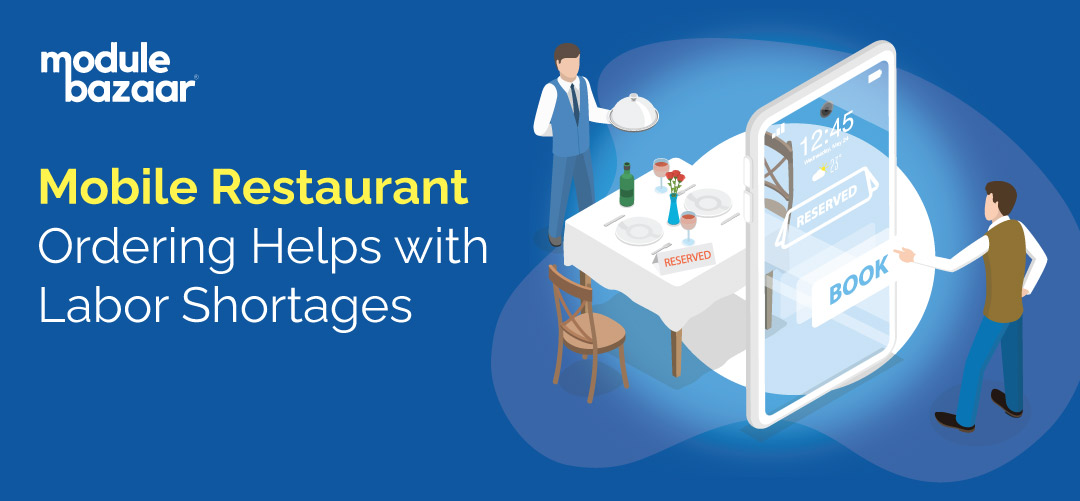Share the post "As Restaurant Labor Shortages Rise, Mobile Ordering Can Help"
Restaurants are focused on getting back to normal in 2021, but they are still facing challenges such as employee shortages and adjustments to new trends. In a time when many restaurants have closed permanently and others are dealing with lower revenue, they are uncertain how to approach new obstacles. Technologies like mobile ordering have transformed the industry, and they have the potential to help restaurants work around labor conditions and other issues they are dealing with right now.
Employment in the restaurant industry is still below pre-pandemic levels, with 2.5 million jobs in the U.S. food and drink industry wiped away from March 2020 to January 2021. The numbers are gradually rising again, with the industry adding a net seasonally adjusted 175,800 jobs in March 2021. Still, all 50 states are below 2019 levels, with many restaurants unable to fully open, some unable to support a full staff, and the total number of restaurants and bars being lower than it was a year ago.
As hiring rises, many food and drink establishments have noted the difficulty in finding applicants, with an unexpected labor shortage in the industry. Many employees have left the industry and found positions in other areas, reducing the labor pool, but various explanations have been cited for why restaurants have difficulty hiring: low wages, reasons of personal safety, and frustration at the industry in general. Many employees are concerned about their safety versus earnings, it’s not worth it to come back to work right now but may change their minds later. Others may have been frustrated with the inconsistency of regulations during the pandemic that led to instability and uncertainty of whether their jobs were secure.
These conditions have affected both waitstaff and back-of-house staff, with cooks in high demand according to Eater. Back-of-house staff faced less layoffs since kitchens were able to operate for off-premises sales during the pandemic, but the disruptions have caused many employees to leave anyway.
Diners are still split about returning, with 60% saying they were comfortable eating indoors and the number rising gradually. But if indoor dining rises this summer, restaurants are expecting difficulties in their normal operations, especially as fewer options are available for patrons.
Read also: How Can a Mobile-Focused Drive-Thru Model Help Restaurant Sales in 2021?
New Tools for Dealing with Staffing Issues
Restaurants are addressing their staffing issues with higher wages and better conditions, but they can use different organizational methods as well as technology to ease the burden. Some are considering changing their business model, such as suspending table service to reduce their waitstaff. Ordering and payment kiosks can support this option, letting customers order at their own pace and send orders to the kitchen, then pay electronically.
Mobile apps have shaken up the way restaurants deal with their customers, and a mobile app with the right features can save work for employees. For instance, online orders take less work to receive and process than phone orders, and payment through an app takes the burden off of staff for credit card processing or payment on delivery.
Overcrowding is expected to become a problem, and restaurants may have to turn customers away. Restaurants can use the mobile app as an option for patrons who want to try the restaurant but find it’s too busy. Additionally, they can use communication features such as push notifications to update patrons on when they are reopening and when they have indoor seating available. They can also state when they are busy and suggest making reservations or ordering for off-premises sales.
Restaurants may want to use promotions to attract customers back, but with higher labor and inventory costs, they may want to avoid large discounts. Mobile app sales help with this, since off-premise orders have been found to average 50% more than in-person sales. Meanwhile, they can also offer loyalty programs that give discounts and other benefits based on spending, bringing revenue now rather than reducing profits and increasing the number of regular customers. These programs are more effective in both the short and long term in boosting sales, while also requiring fewer employee resources devoted to marketing.
Businesses are in a tough situation, but as time goes on, the employment market and other disrupted areas of the economy are expected to recover. Using technology to its full potential and reorganizing around the current limitations can help restaurants grow their business better than ever


